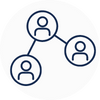As an increasing number of organizations commit themselves to workforce diversity and inclusion initiatives, growing attention has been given to supporting individuals on the autism spectrum.
Autism spectrum disorder (ASD) refers to a broad range of neurological developmental disabilities that can negatively impact communication skills, social behaviors, and sensory sensitivities. Autism is understood as a “spectrum” disorder because the symptoms and abilities of individuals with autism vary widely from person to person, ranging from mild to severe and debilitative.
While every individual’s experience with autism is different, challenges most often identified with ASD include varying degrees of
- sensitivity to sounds, textures, and pain
- intense interest in a narrow range of topics
- rigid attachment to routines, patterns, or behaviors
- difficulty communicating and interacting with others
As ASD is becoming better understood, many are recognizing that the neurological differences associated with ASD can also translate into valuable workplace skills. For example, a strong awareness of patterns means that many individuals on the spectrum excel in math, sequencing, coding, and other data-driven processes. In fact, 16 percent of students with autism who pursue postsecondary education choose computer science fields (Annabi et al., 2019).
Other strengths commonly associated with ASD include
- high levels of concentration and attention to detail
- capacity for interferential reasoning
- strong ability to identify errors
- creative problem solving
- unique perspectiveand “outside-the-box” thinking
- ability to build, analyze, and understand complex systems
- persistence
- exceptional memory
- innovation
- loyalty
- trustworthiness
- productivity
- reliability
Even though an estimated 60 percent of individuals with autism have average or above-average intelligence, the unemployment rate for people on the spectrum is high, even for those who graduated from college. It is thought that traditional methods of recruitment and hiring, including the emphasis on social engagement, put individuals with ASD at a disadvantage.
In recent years, several major corporations, including Microsoft, SAP, and JP Chase Morgan, have developed neurodiversity inclusion programs to recruit and support employees who are on the autism spectrum. For these organizations, the investment has aligned with their organization’s culture and social responsibility efforts and met their talent needs (Annabi et al., 2019).
At JP Chase Morgan, individuals with ASD have been recruited to serve in a number of competitive roles, including fraud analysts, compliance analysts, and data scientists. JP Chase Morgan’s ROI data revealed that the individuals in their pilot program were 48 percent more productive after six months than their neurotypical counterparts. The second class of participants were 90 to 140 percent more productive, with zero errors after six months (Annabi et al., 2019).
Organizational leaders say that individuals on the spectrum are not only helping address talent shortages in areas that are typically difficult to fill, but they are also providing a more diverse workplace experience for all employees. There were unexpected benefits as well. Once organizations created more inclusive environments, they found that existing employees began to self-disclose their own autism diagnoses, which they had previously kept hidden. Communication across the organizations improved as well, and managers involved in the program became better leaders overall (Annabi et al., 2019).


































